
Introduction
The format of this book is simple: There are 365 lessons so that you can study one each day for a year. Each lesson consists of a short annotated game and at least one quiz question to test you. At the end of the lesson you will find an additional game that illustrates the opening or strategic themes of the main game. Try to set aside at least an hour for each lesson. You can get the most out of it by playing the main game over at least twice. The first time will give you a general sense of why the game was won or lost.
The second time will allow you to look more closely at the tactics and strategy. You might look at it once more, this time with colors reversed, seeing the board from Blacks viewpoint rather than Whites. Youd be surprised how often this reversal changes your appreciation of what happened. If you are using a computer program, make sure to look at the illustrative game with it to see any tactical ideas you might have missed. Feel free to move on to a second lesson each day after youve finished the first. But dont leave a lesson until you can describe what happened in the main game.
Describe it in words, not White won because 17 xc5+ Kg8 18 Rg1+. Im hoping that at the end of each lesson you will have that feeling all too rare in chess that youve learned something today. Almost all the main games in this book last 20 moves or less. The early lessons have most of the very short games and the more basic tactical ideas. Longer games and more complex positional ideas are tackled later on. Most of the games were played by masters, so some will end when a player loses a piece and resigns.
Other games may last until checkmate. Dont be surprised if you find some games helpful, others difficult and still others too easy. Each student progresses in their own way. And dont feel upset if you cant answer the daily quiz questions. Some are based on simple tactics but others are much more difficult. The answers are at the back of this book.
Of course, there is a lot that this book does not cover. Games of less than 20 moves end much too early to provide meaningful instruction about the endgame. Nor is this the book that will teach you the finer points of openings. Many of the games begin with gambits, some long out of fashion. But they are here because they illustrate important concepts like compensation and initiative and demonstrate the many combinational patterns that you need to know. And most of these games were chosen because they are entertaining.
If you arent enjoying chess as you study it, you wont keep at it. So have a good year!
DAY 1 Take What He Gives
Almost every move by your opponent has good and less good features.
You win by exploiting the latter.Jan TimmanWhiteMustafa Ahmed BakaliBlack Nice 1974
Center Counter Defense B011 e4 d5 2 exd5f6 3 d4xd5 4 c4 Quieter play, 4 f3 g6 5 e2 g7 6 0-0, promises a modest White advantage, at most.
4...b6 5f3g4 Now on 6 e2 Black can play ...xf3 when xf3 would allow ...xc4. On 6 b3 he gets active piece play from 6...xf3 7 xf3 c6. Thats whats good about 5...g4.
6 c5! Now 6...6d7 7 c4 grants White the more active pieces.
6...d5?
This natural move is a serious error but only if White appreciates what Black has given him.
6...d5?
This natural move is a serious error but only if White appreciates what Black has given him.
Black would be solid after 7 c4? c6 8 c3 e6. 7 b3! Attacking both the knight and b-pawn. Black loses material after 7...xf3 8 xb7!. 7...b6? Best is the humble 7...c8!. The loss of time is far outweighed by its benefit, keeping the game going. 8 e5! resigns.: What happens on 8...e6 ?Esther De KleuverWhiteStaffan ThomassonBlack Dieren 2006 1 e4 d5 2 exd5 f6 3 f3 xd5 4 d4 g4 5 c4 b6 6 c5 d5 7 b3 c8 8 c4 c6 9 c3 e6 10 0-0 e7 11 e1 0-0 12 e4 f6 13 eg5 d5 14 d3 g6 15 h4 d7 16 h5 b6 17 hxg6 hxg6 18 xe6 f6 19 xc6 xg5 20 xg5 7f6 21 xf6 resigns (21...xf6 22 xg6+).
DAY 2 Oldest, Essential
A last rank mate is the oldest mating pattern.
And the most common.DAY 2 Oldest, Essential
A last rank mate is the oldest mating pattern.
And the most common.
That makes mastering it essential knowledge.Alexander AlekhineWhiteFriedrich KoehnleinBlack Dusseldorf 1908 Colle System D051 d4 d5 2 f3 e6 3 e3 f6 4 d3 bd7 5 bd2 d6 6 e4 dxe4 7 xe4 xe4 8 xe4 0-0 9 g5 White tries to provoke 9...f6 since Blacks e6-pawn would be a bit weak. But 9...e7! is fine for Black. 9...e8? 10 0-0 f5 11 d3 Blacks last two moves prepared 11...h5 followed by trapping the g5-bishop with 12...f4 and 13...h6. That also sets up ...e5, e.g. 11...h5 12 e2 e5! 13 dxe5 xe5 14 xe5 xe2!. However, White can improve with 12 e1!.
Then 12...e5? 13 dxe5 xe5 14 xe5 xg5 loses to 15 c4+ h8 16 f7+!, as well see later. So Black goes for the immediate 11...e5? 12 dxe5 xe5 13 e1! Now 13...xf3+ 14 xf3 favors White after 14...f7 15 b3 and c4. Or 14...a4 15 e7 xe7 16 d5+ and 17 xe7. : What about 14...g6 15e7xe7 16xe7f6 and then 17ae1xb2 ?13...h5 14 xe5 xg5 15 c4+ h8 16 xd6! Much stronger than winning the Exchange (16 f7+ xf7). Now 16...cxd6 allows the decisive check 17 f7+ because 17...xf7 18 e8+ mates. Black resigned, after 16...xg2+17 xg2.
16 xd6! Much stronger than winning the Exchange (16 f7+ xf7). Now 16...cxd6 allows the decisive check 17 f7+ because 17...xf7 18 e8+ mates. Black resigned, after 16...xg2+17 xg2.
This game and the following are just variations of the basic last-rank mating pattern. Tihomil DrezgaWhiteAbraham BaratzBlack Paris 1929 1 e4 e5 2 f3 c6 3 c4 f6 4 d4 exd4 5 0-0 d6 6 xd4 e7 7 c3 0-0 8 f4 g4 9 xc6 bxc6 10 e1? (10 d3!) d5! 11 d3 dxe4 12 xe4 e8! 13 h1 c5 14 g3? xe4 15 xg4 xd3! White resigns.
DAY 3 Opportunity Knocks
The door of tactical opportunity usually stays open for an instant.Tigran PetrosianWhiteNikolai GrigorievBlack Tbilisi 1945
Sicilian Defense, Nimzovich Variation B291 e4 c5 2 f3 f6 3 e5 d5 4 c3 xc3 5 dxc3 b6?
Here 6 d3? b7 7 f4 c7 closes the door of opportunity. Whites edge is minimal.
6 e6! But now he wins, e.g. 6...fxe6 7 e5 threatens both 8 h5+ g6 9 xg6 and 8 f3.
6...dxe6 7 xd8+!: Why not 7b5+ and 8e5 with a threat of 9f3 ?7...xd8 8 e5 e8 Or 8...g8 9 xf7+ e8 10 g5! and wins.
Next page
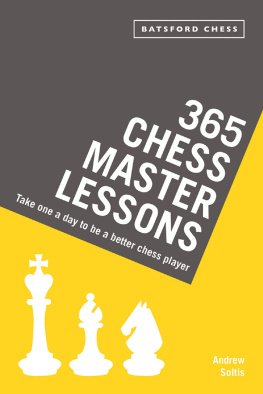
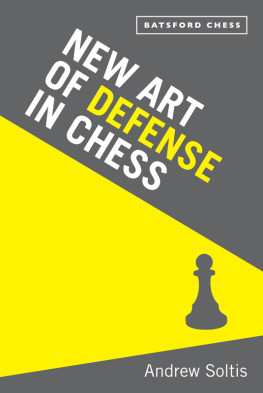
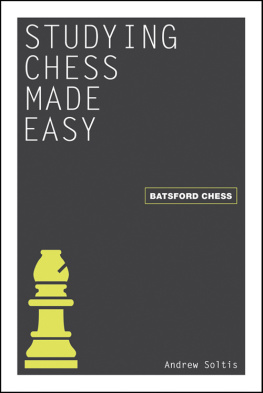
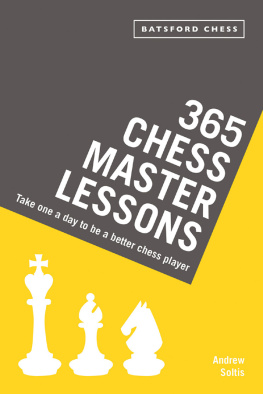
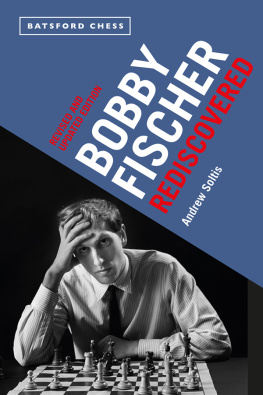
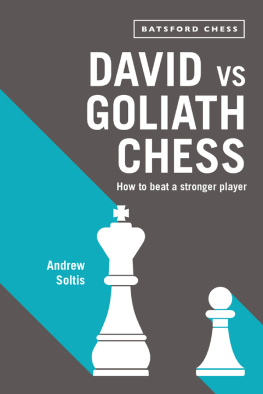
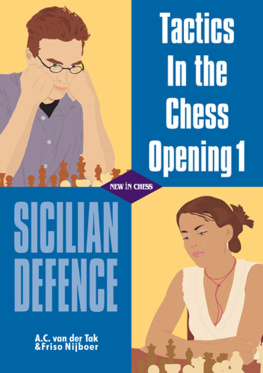
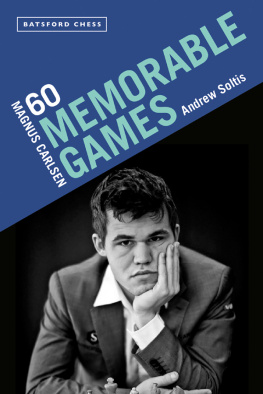
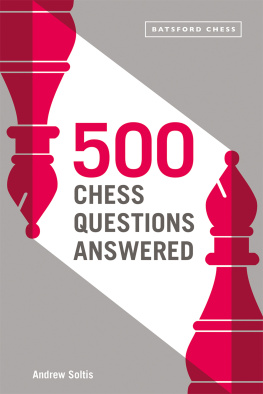
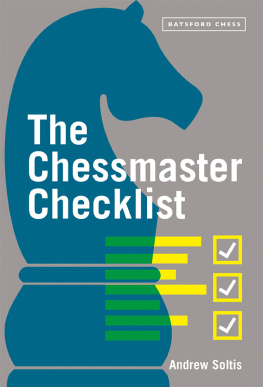
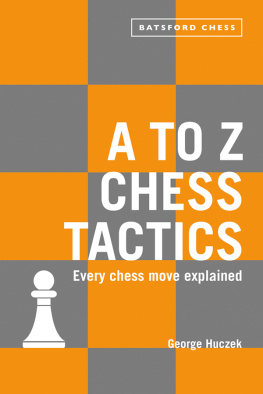
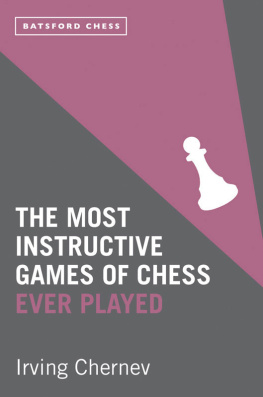
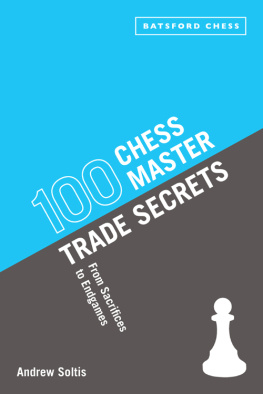

 This natural move is a serious error but only if White appreciates what Black has given him. 6...d5?
This natural move is a serious error but only if White appreciates what Black has given him. 6...d5? 16 xd6! Much stronger than winning the Exchange (16 f7+ xf7). Now 16...cxd6 allows the decisive check 17 f7+ because 17...xf7 18 e8+ mates. Black resigned, after 16...xg2+17 xg2.
16 xd6! Much stronger than winning the Exchange (16 f7+ xf7). Now 16...cxd6 allows the decisive check 17 f7+ because 17...xf7 18 e8+ mates. Black resigned, after 16...xg2+17 xg2. Here 6 d3? b7 7 f4 c7 closes the door of opportunity. Whites edge is minimal. 6 e6! But now he wins, e.g. 6...fxe6 7 e5 threatens both 8 h5+ g6 9 xg6 and 8 f3. 6...dxe6 7 xd8+!: Why not 7b5+ and 8e5 with a threat of 9f3 ?7...xd8 8 e5 e8 Or 8...g8 9 xf7+ e8 10 g5! and wins.
Here 6 d3? b7 7 f4 c7 closes the door of opportunity. Whites edge is minimal. 6 e6! But now he wins, e.g. 6...fxe6 7 e5 threatens both 8 h5+ g6 9 xg6 and 8 f3. 6...dxe6 7 xd8+!: Why not 7b5+ and 8e5 with a threat of 9f3 ?7...xd8 8 e5 e8 Or 8...g8 9 xf7+ e8 10 g5! and wins.